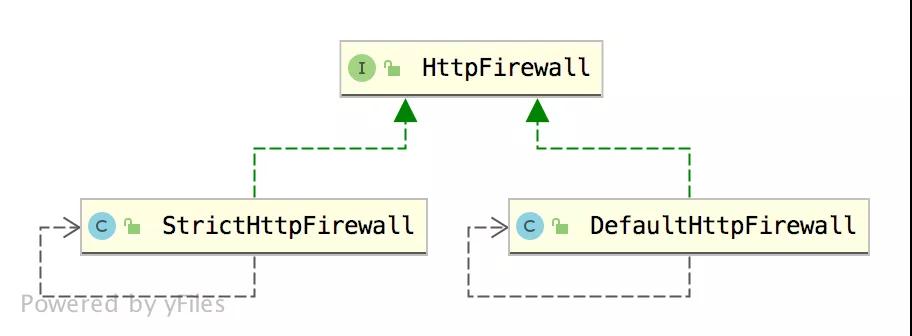SpringSecurity系列之請求防火墻默認已開啟
之前有小伙伴表示,看 Spring Security 這么麻煩,不如自己寫一個 Filter 攔截請求,簡單實用。
自己寫當(dāng)然也可以實現(xiàn),但是大部分情況下,大家都不是專業(yè)的 Web 安全工程師,所以考慮問題也不過就是認證和授權(quán),這兩個問題處理好了,似乎系統(tǒng)就很安全了。
其實不是這樣的!
各種各樣的 Web 攻擊每天都在發(fā)生,什么固定會話攻擊、csrf 攻擊等等,如果不了解這些攻擊,那么做出來的系統(tǒng)肯定也不能防御這些攻擊。
使用 Spring Security 的好處就是,即使不了解這些攻擊,也不用擔(dān)心這些攻擊,因為 Spring Security 已經(jīng)幫你做好防御工作了。
我們常說相比于 Shiro,Spring Security 更加重量級,重量級有重量級的好處,比如功能全,安全管理更加完備。用了 Spring Security,你都不知道自己的系統(tǒng)有多安全!
今天我就來和大家聊一聊 Spring Security 中自帶的防火墻機制。
好了,不廢話了,我們來看文章。
1.HttpFirewall
在 Spring Security 中提供了一個 HttpFirewall,看名字就知道這是一個請求防火墻,它可以自動處理掉一些非法請求。
HttpFirewall 目前一共有兩個實現(xiàn)類:
一個是嚴格模式的防火墻設(shè)置,還有一個默認防火墻設(shè)置。
DefaultHttpFirewall 的限制相對于 StrictHttpFirewall 要寬松一些,當(dāng)然也意味著安全性不如 StrictHttpFirewall。
Spring Security 中默認使用的是 StrictHttpFirewall。
2.防護措施
那么 StrictHttpFirewall 都是從哪些方面來保護我們的應(yīng)用呢?我們來挨個看下。
2.1 只允許白名單中的方法
首先,對于請求的方法,只允許白名單中的方法,也就是說,不是所有的 HTTP 請求方法都可以執(zhí)行。
這點我們可以從 StrictHttpFirewall 的源碼中看出來:
- public class StrictHttpFirewall implements HttpFirewall {
- private Set<String> allowedHttpMethods = createDefaultAllowedHttpMethods();
- private static Set<String> createDefaultAllowedHttpMethods() {
- Set<String> result = new HashSet<>();
- result.add(HttpMethod.DELETE.name());
- result.add(HttpMethod.GET.name());
- result.add(HttpMethod.HEAD.name());
- result.add(HttpMethod.OPTIONS.name());
- result.add(HttpMethod.PATCH.name());
- result.add(HttpMethod.POST.name());
- result.add(HttpMethod.PUT.name());
- return result;
- }
- private void rejectForbiddenHttpMethod(HttpServletRequest request) {
- if (this.allowedHttpMethods == ALLOW_ANY_HTTP_METHOD) {
- return;
- }
- if (!this.allowedHttpMethods.contains(request.getMethod())) {
- throw new RequestRejectedException("The request was rejected because the HTTP method \"" +
- request.getMethod() +
- "\" was not included within the whitelist " +
- this.allowedHttpMethods);
- }
- }
- }
從這段代碼中我們看出來,你的 HTTP 請求方法必須是 DELETE、GET、HEAD、OPTIONS、PATCH、POST 以及 PUT 中的一個,請求才能發(fā)送成功,否則的話,就會拋出 RequestRejectedException 異常。
那如果你想發(fā)送其他 HTTP 請求方法,例如 TRACE ,該怎么辦呢?我們只需要自己重新提供一個 StrictHttpFirewall 實例即可,如下:
- @Bean
- HttpFirewall httpFirewall() {
- StrictHttpFirewall firewall = new StrictHttpFirewall();
- firewall.setUnsafeAllowAnyHttpMethod(true);
- return firewall;
- }
其中,setUnsafeAllowAnyHttpMethod 方法表示不做 HTTP 請求方法校驗,也就是什么方法都可以過。或者也可以通過 setAllowedHttpMethods 方法來重新定義可以通過的方法。
2.2 請求地址不能有分號
不知掉大家有沒有試過,如果你使用了 Spring Security,請求地址是不能有 ; 的,如果請求地址有 ; ,就會自動跳轉(zhuǎn)到如下頁面:
可以看到,頁面的提示中已經(jīng)說了,因為你的請求地址中包含 ;,所以請求失敗。
什么時候請求地址中會包含 ; 呢?不知道小伙伴們在使用 Shiro 的時候,有沒有注意到,如果你禁用了 Cookie,那么 jsessionid 就會出現(xiàn)在地址欄里,像下面這樣:
- http://localhost:8080/hello;jsessionid=xx
這種傳遞 jsessionid 的方式實際上是非常不安全的(松哥后面的文章會和大家細聊這個問題),所以在 Spring Security 中,這種傳參方式默認就禁用了。
當(dāng)然,如果你希望地址欄能夠被允許出現(xiàn) ; ,那么可以按照如下方式設(shè)置:
- @Bean
- HttpFirewall httpFirewall() {
- StrictHttpFirewall firewall = new StrictHttpFirewall();
- firewall.setAllowSemicolon(true);
- return firewall;
- }
設(shè)置完成之后,再去訪問相同的接口,可以看到,此時雖然還是報錯,但是錯誤是 404 了,而不是一開始那個不允許 ; 的錯了。
注意,在 URL 地址中,; 編碼之后是 %3b 或者 %3B,所以地址中同樣不能出現(xiàn) %3b 或者 %3B
題外話
有的小伙伴可能不知道或者沒用過,Spring3.2 開始,帶來了一種全新的傳參方式 @MatrixVariable。
@MatrixVariable 是 Spring3.2 中帶來的功能,這種方式拓展了請求參數(shù)的傳遞格式,使得參數(shù)之間可以用 ; 隔開,這種傳參方式真是哪壺不開提哪壺。因為 Spring Security 默認就是禁止這種傳參方式,所以一般情況下,如果你需要使用 @MatrixVariable 來標(biāo)記參數(shù),就得在 Spring Security 中額外放行。
接下來我通過一個簡單的例子來和大家演示一下 @MatrixVariable 的用法。
我們新建一個 /hello 方法:
- @RequestMapping(value = "/hello/{id}")
- public void hello(@PathVariable Integer id,@MatrixVariable String name) {
- System.out.println("id = " + id);
- System.out.println("name = " + name);
- }
另外我們還需要配置一下 SpringMVC,使 ; 不要被自動移除了:
- @Configuration
- public class WebMvcConfig extends WebMvcConfigurationSupport {
- @Override
- protected void configurePathMatch(PathMatchConfigurer configurer) {
- UrlPathHelper urlPathHelper = new UrlPathHelper();
- urlPathHelper.setRemoveSemicolonContent(false);
- configurer.setUrlPathHelper(urlPathHelper);
- }
- }
然后啟動項目(注意,Spring Security 中也已經(jīng)配置了允許 URL 中存在 ;),瀏覽器發(fā)送如下請求:
- http://localhost:8080/hello/123;name=javaboy
控制臺打印信息如下:
- id = 123
- name = javaboy
可以看到,@MatrixVariable 注解已經(jīng)生效了。
2.3 必須是標(biāo)準(zhǔn)化 URL
請求地址必須是標(biāo)準(zhǔn)化 URL。
什么是標(biāo)準(zhǔn)化 URL?標(biāo)準(zhǔn)化 URL 主要從四個方面來判斷,我們來看下源碼:
StrictHttpFirewall#isNormalized:
- private static boolean isNormalized(HttpServletRequest request) {
- if (!isNormalized(request.getRequestURI())) {
- return false;
- }
- if (!isNormalized(request.getContextPath())) {
- return false;
- }
- if (!isNormalized(request.getServletPath())) {
- return false;
- }
- if (!isNormalized(request.getPathInfo())) {
- return false;
- }
- return true;
- }
getRequestURI 就是獲取請求協(xié)議之外的字符;getContextPath 是獲取上下文路徑,相當(dāng)于是 project 的名字;getServletPath 這個就是請求的 servlet 路徑,getPathInfo 則是除過 contextPath 和 servletPath 之后剩余的部分。
這四種路徑中,都不能包含如下字符串:
- "./", "/../" or "/."
2.4 必須是可打印的 ASCII 字符
如果請求地址中包含不可打印的 ASCII 字符,請求則會被拒絕,我們可以從源碼中看出端倪:
StrictHttpFirewall#containsOnlyPrintableAsciiCharacters
- private static boolean containsOnlyPrintableAsciiCharacters(String uri) {
- int length = uri.length();
- for (int i = 0; i < length; i++) {
- char c = uri.charAt(i);
- if (c < '\u0020' || c > '\u007e') {
- return false;
- }
- }
- return true;
- }
2.5 雙斜杠不被允許
如果請求地址中出現(xiàn)雙斜杠,這個請求也將被拒絕。雙斜杠 // 使用 URL 地址編碼之后,是 %2F%2F,其中 F 大小寫無所謂,所以請求地址中也能不出現(xiàn) "%2f%2f", "%2f%2F", "%2F%2f", "%2F%2F"。
如果你希望請求地址中可以出現(xiàn) // ,可以按照如下方式配置:
- @Bean
- HttpFirewall httpFirewall() {
- StrictHttpFirewall firewall = new StrictHttpFirewall();
- firewall.setAllowUrlEncodedDoubleSlash(true);
- return firewall;
- }
2.6 % 不被允許
如果請求地址中出現(xiàn) %,這個請求也將被拒絕。URL 編碼后的 % 是 %25,所以 %25 也不能出現(xiàn)在 URL 地址中。
如果希望請求地址中可以出現(xiàn) %,可以按照如下方式修改:
- @Bean
- HttpFirewall httpFirewall() {
- StrictHttpFirewall firewall = new StrictHttpFirewall();
- firewall.setAllowUrlEncodedPercent(true);
- return firewall;
- }
2.7 正反斜杠不被允許
如果請求地址中包含斜杠編碼后的字符 %2F 或者 %2f ,則請求將被拒絕。
如果請求地址中包含反斜杠 \ 或者反斜杠編碼后的字符 %5C 或者 %5c ,則請求將被拒絕。
如果希望去掉如上兩條限制,可以按照如下方式來配置:
- @Bean
- HttpFirewall httpFirewall() {
- StrictHttpFirewall firewall = new StrictHttpFirewall();
- firewall.setAllowBackSlash(true);
- firewall.setAllowUrlEncodedSlash(true);
- return firewall;
- }
2.8 . 不被允許
如果請求地址中存在 . 編碼之后的字符 %2e、%2E,則請求將被拒絕。
如需支持,按照如下方式進行配置:
- @Bean
- HttpFirewall httpFirewall() {
- StrictHttpFirewall firewall = new StrictHttpFirewall();
- firewall.setAllowUrlEncodedPeriod(true);
- return firewall;
- }
2.9 小結(jié)
需要強調(diào)一點,上面所說的這些限制,都是針對請求的 requestURI 進行的限制,而不是針對請求參數(shù)。例如你的請求格式是:
- http://localhost:8080/hello?param=aa%2ebb
那么 2.7 小節(jié)說的限制和你沒關(guān)系。
這個大家從 StrictHttpFirewall 源碼中很容易看到:
- public class StrictHttpFirewall implements HttpFirewall {
- @Override
- public FirewalledRequest getFirewalledRequest(HttpServletRequest request) throws RequestRejectedException {
- rejectForbiddenHttpMethod(request);
- rejectedBlacklistedUrls(request);
- rejectedUntrustedHosts(request);
- if (!isNormalized(request)) {
- throw new RequestRejectedException("The request was rejected because the URL was not normalized.");
- }
- String requestUri = request.getRequestURI();
- if (!containsOnlyPrintableAsciiCharacters(requestUri)) {
- throw new RequestRejectedException("The requestURI was rejected because it can only contain printable ASCII characters.");
- }
- return new FirewalledRequest(request) {
- @Override
- public void reset() {
- }
- };
- }
- private void rejectedBlacklistedUrls(HttpServletRequest request) {
- for (String forbidden : this.encodedUrlBlacklist) {
- if (encodedUrlContains(request, forbidden)) {
- throw new RequestRejectedException("The request was rejected because the URL contained a potentially malicious String \"" + forbidden + "\"");
- }
- }
- for (String forbidden : this.decodedUrlBlacklist) {
- if (decodedUrlContains(request, forbidden)) {
- throw new RequestRejectedException("The request was rejected because the URL contained a potentially malicious String \"" + forbidden + "\"");
- }
- }
- }
- private static boolean encodedUrlContains(HttpServletRequest request, String value) {
- if (valueContains(request.getContextPath(), value)) {
- return true;
- }
- return valueContains(request.getRequestURI(), value);
- }
- private static boolean decodedUrlContains(HttpServletRequest request, String value) {
- if (valueContains(request.getServletPath(), value)) {
- return true;
- }
- if (valueContains(request.getPathInfo(), value)) {
- return true;
- }
- return false;
- }
- private static boolean valueContains(String value, String contains) {
- return value != null && value.contains(contains);
- }
- }
rejectedBlacklistedUrls 方法就是校驗 URL 的,該方法邏輯很簡單,我就不再贅述了。
注意:雖然我們可以手動修改 Spring Security 中的這些限制,但是松哥不建議大家做任何修改,每一條限制都有它的原由,每放開一個限制,就會帶來未知的安全風(fēng)險。后面松哥在和大家分享 Web 中的安全攻擊時,也會再次提到這些限制的作用,請小伙伴們保持關(guān)注哦。
3.總結(jié)
沒想到吧?Spring Security 竟然為你做了這么多事情!正好應(yīng)了那句雞湯:你所謂的歲月靜好,不過是有人在替你負重前行。





























